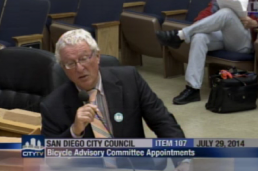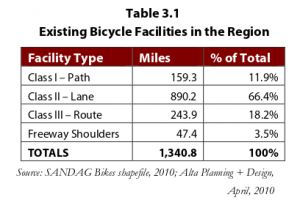Oceanside Councilmember Jack Feller: Squandering Billions of Taxpayer Dollars to Shave Seconds of his Personal Car Commute
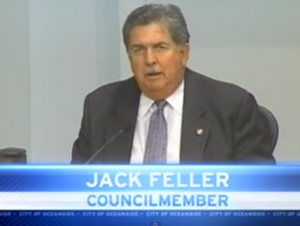
Jack Feller is an Oceanside Councilmember. Feller serves as the city of Oceanside's main representative to the SANDAG board. The population of Oceanside per the 2010 census is 167,086 or roughly 5% of the county's population.
The SANDAG board is comprised of twenty representatives in San Diego County. Each of the county's eighteen cities and the County of San Diego's Board of Supervisor's have one representative and two alternates that sit on the board and vote on all SANDAG issues that affect the entire San Diego region (the city of San Diego has two representatives). While the representatives themselves are elected by their own electorate, the seats to the SANDAG board are appointed by the main representative of that jurisdiction. So for example, San Diego's mayor, Kevin Faulconer is one of the representatives to the SANDAG board. He also has the power to appoint two alternates to represent the city of San Diego.
 This appointment process means that the representatives themselves don't have an incentive to be accountable to the entire region. Since the public doesn’t vote on who gets to represent them on the SANDAG board, we have individuals like Oceanside councilmember, Jack Feller spouting off complete nonsense at SANDAG board meetings. Because of how representatives are appointed to the SANDAG board, the process of deciding who gets to sit on the board is based on the arbitrary whims of local politicians.
This appointment process means that the representatives themselves don't have an incentive to be accountable to the entire region. Since the public doesn’t vote on who gets to represent them on the SANDAG board, we have individuals like Oceanside councilmember, Jack Feller spouting off complete nonsense at SANDAG board meetings. Because of how representatives are appointed to the SANDAG board, the process of deciding who gets to sit on the board is based on the arbitrary whims of local politicians.
Last Friday, two of the network scenarios for the updated Regional Transportation Plan (RTP) were presented to the SANDAG board as an information item for discussion. The full board is scheduled to adopt the updated RTP next summer.
As a reminder, the current RTP that is being updated was sued and the lawsuit was upheld by Judge Timothy Taylor. Yet the SANDAG board voted to appeal that decision, the cost of which is being born by San Diego County's taxpayers.

A survey prepared for the San Diego Foundation in 2010 revealed that the majority of San Diegans supported development around transit and expansion of transit services in the region. But Jack Feller doesn't seem to base his decision making and voting power on data or facts or even voters' wishes. Feller's decision making ability stems from his own personal commute and misconceived beliefs on what constitutes a strong economy.
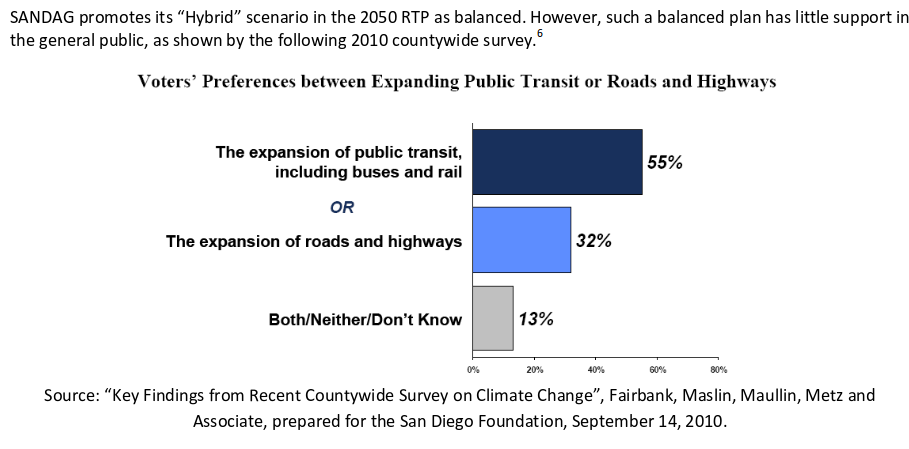
At a little over 42 square miles, Oceanside is serviced by multiple transit lines including the Coaster and the Sprinter. Feller could have taken the Coaster down to downtown San Diego and walked to his SANDAG board meeting located at 4th and B. Instead he spent 45 minutes on various freeways and decided that what this region needed was more freeways.
On Friday, the SANDAG staff presented the draft RTP to the SANDAG board. The details of this plan is still being ironed out. However, two of the network scenarios appear to be finalized and were presented for discussion. Many members of the public, including myself, showed up to speak to ask for a third scenario and to front load transit and bicycling and walking investments prior to implementing any highway widening projects.
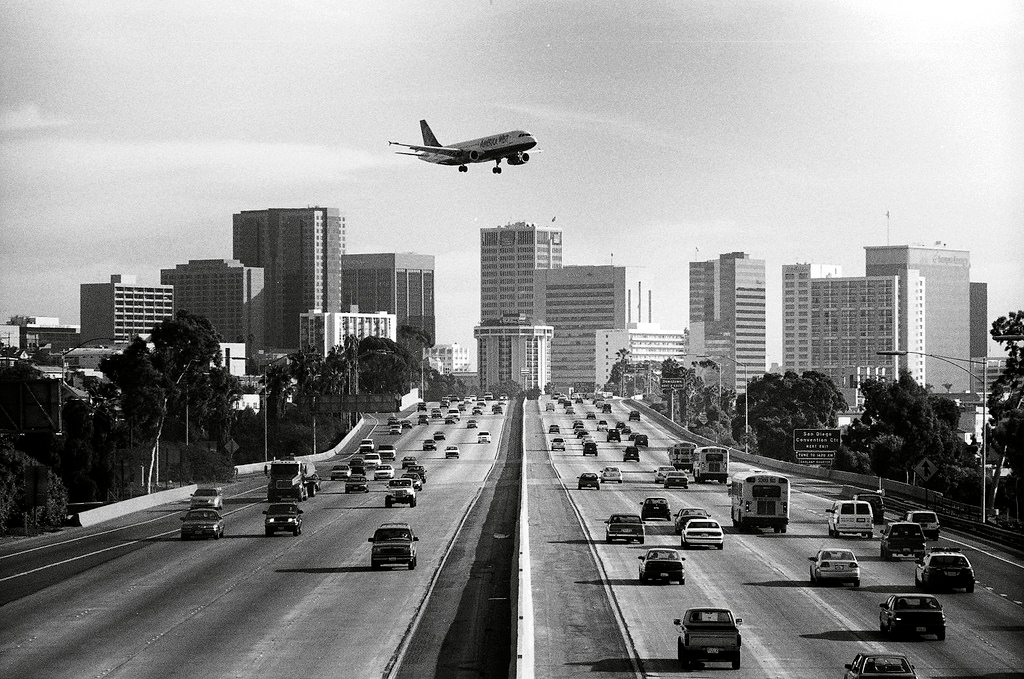
Feller went on to quote Mayor Faulconer who commended the Coastal Commission's vote to expand the I-5 (which is also under litigation) last Wednesday stating that the I-5 was a “gateway to San Diego.”
Feller in the same breath went on to state, “you know right now [the] Coast Highway is jammed through Oceanside, Carlsbad all the way down. So […]...that's like a second arterial. And its not good for our business, I know.”
Feller's solution? More freeways and expansions of existing freeways, preferably with tolls which don't pencil out financially.
“The four lanes is going to be absolutely a necessity Otherwise we are not going to be able to move in Oceanside. So Scenario 2 as far as managed lanes and highway improvements is what I support.”
Continuing to demonstrate his whimsical decision making skills based random observation, Feller went on to discuss his experience in Davis, CA (one of California's most bike friendly cities). Davis is very accommodating and inviting to ride a bicycle, yet Feller still expressed suspicion that investments made to increasing bicycling use would not be worthwhile because he didn't see enough people riding alongside a busy interstate between Davis and Sacramento,
“And I did want to make a comment about bicycling. UC Davis is where I have a grandson going to school. There I've never seen so many bikes. They have a causeway between Sacramento and UC Davis. They built a lane on the side of the freeway just for bikes and I was back and forth across that thing eight times in a matter of two days and I saw seventeen bicycle riders on that six mile stretch of pretty expensive freeway lane. So not everyone wants to ride a bike, I know everyone dreams about having a car.”
Rather than working to ensure a region that is safe for everyone or even working to build a robust San Diego economy that is not energy dependent on unstable foreign countries, Feller's solution and contribution to our regional decision making process was all about shaving a few seconds of his own personal car commute. One would hardly call Feller a representative of anything except a role model for wasting precious tax payer dollars.
A Call for the Resignation of Uptown Planners Chair, Leo Wilson
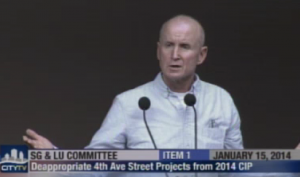
Sign the petition calling on Leo Wilson to resign from Uptown Planners.
---
Last month on July 8th, I sent an email to Leo Wilson, current chair of Uptown Planners Community Planning Group. The emailed called for him to resign from the Uptown Planners Community Planning Group.
Uptown Planners is the city recognized Community Planning Group that serves as an advisory board to the City of San Diego regarding land use and development projects in the neighborhoods of Bankers Hill, Hillcrest, Mission Hills and University Heights. In 2010 under Wilson's leadership, Uptown Planners rejected the city's plans to install bike lanes (stripes of paint) on India Street and Kettner Boulevard. Wilson stated (with zero evidence to back up his claims) that "the plan’s impact [was] extreme to small businesses,”. I have yet to find evidence anywhere in the country that dedicated bike infrastructure negatively impacts businesses. Today, we have sharrows on India street where someone on a bicycle is expected to "share" road space with a multi-ton vehicle that could kill them in an instant.
More recently, Uptown Planners, under Wilson's leadership, opposed the implementation of the buffered bike lanes on 4th and 5th Avenues.
Despite giving Wilson the benefit of the doubt and the time to demonstrate that he simply didn't have a bias against bicyclists, he has demonstrated time and time again that the only perspective he cares about are some of the out of date views on driving, while simultaneously advocating for the storage of private vehicles on public space - our city streets.
Our petition calling on Leo Wilson to resign from the Uptown Planners Community Planning Board was covered by Uptown News yesterday. The story included this response from Wilson,
It’s interesting because Ollinger attacked me for the [2011 India Street bike lane proposal], but that would have taken out over 100 parking spaces. That would have been devastating to businesses
A community leader needs to be both reasonable and open to perspectives from everyone. Wilson has demonstrated, as recently as yesterday, that the only perspective he cares about are drivers while voicing opinions with no basis in fact.
For more than nine years, Wilson as the head of Uptown Planners has shown no initiative or leadership to accommodate anyone by drivers. It's time he steps down so that someone who is a true community leader can actually lead Uptown to the future.

San Diego City Council Adopts City's First Bicycle Advisory Committee
Earlier this week, on Tuesday, San Diego's City Council unanimously approved the creation of the city's first Bicycle Advisory Committee. This was a goal that was originally proposed in the 2002 city adopted bike plan, the city's second plan to accommodate bicycling.

Getting this committee established was one of our goals for our second year of existence (we launched as an organization in 2012). The composition of the committee calls for each Councilmember adopting one appointee and the two appointees made by the Mayor. Districts 4, 6, and 7 do not have a representative yet, so if you live in these neighborhoods now would be a nice time to get to know your elected representatives at City Council.
The current members of this new advisory committee include the following:
- Petr Krysl, involved with bicycling planning in UCSD where he is also a professor, representing District 1
- Nicole Burgess, who has been asking for improvements on Nimitz for as long as this website has been in existence, representing District 2
- Michael Brennan, the founder of San Diego Streets for People and a board member and a voice of reason at the Uptown Parking District representing District 3
- Kathleen Keehan, former executive director of the San Diego County Bicycle Coalition from 1999 to 2011, representing District 5
- Randy Van Vleck, Active Transportation Manager at the City Heights Community Development Corporation, representing District 9
- Andrew Hanshaw, current executive director of the San Diego County Bicycle Coalition and founder of Bike the Bay, representing District 3
- Kyle Heiskala, who led a successful student fee referendum at UCSD for bus and light rail access representing District 3
- and myself, Samantha Ollinger, representing District 8.
If you're not sure what all the District numbers mean, here is a link to a neat map that visually shows the entire city and its council districts.
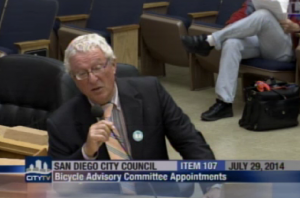
At the Council session on Tuesday, the item to approve the committee was scheduled to be on the consent agenda (essentially voted on without any discussion), however frequent Council Chambers visitor and occasional mayoral candidate, Steven Greenwald, asked for the item to taken out of consent and open for discussion. He was the only member of the public who spoke about the item and he spoke in support of it. He voiced support for "designated bike lanes" and asked that the city look to Vancouver for inspiration. He also talked up bike trains, which Nicole Burgess has been leading in Ocean Beach, and Veronica and Sandra have been leading in Mid-City. Greenwald also mentioned that not all drivers were "sensitive to the fact that bicycles have a place in transportation".
All councilmembers provided positive comments.
Marti Emerald (District 9) stated that perhaps even she could one day be on a bicycle, but that she was "petrified" to ride in traffic today.
Mark Kersey (District 5) thanked Kathy Keehan for her willingness to serve.
Sherri Lightner (District 1) thanked Petr Krysl for his willingness to serve.
Lorie Zapf (District 6 and soon to be District 2) thanked the entire group of committee members and recalled her experience of riding with Burgess and spoke about the needed changes to accommodate the upcoming bike share program as well and changes at Nimitz Boulevard and where the I-8 meets the dog park.
David Alvarez (District 8) spoke about the Climate Action Plan and commended the current District 2 staff that ride to their jobs at City Hall.
Ed Harris (interim Councilmember in District 2) seemed a bit surprised that the issue of bicycling had made a dent at City Hall and made generally positive comments as well.
Scott Sherman (District 7) spoke about the positive effects of seeing more people on bicycles.
Todd Gloria (District 3) stated that this was simply a formalization of the work that all of us had done to date. He also mentioned that the work done in the city to date were "modest" but wanted to see work sped up. Gloria also mentioned that the bike share program was scheduled to launch on October 30th this year. Gloria emphasized that this committee would be working with city staff to advise them on the work that needed to be done.
Emerald made a motion to approve the creation of the Bicycle Advisory Committee and newly re-elected Councilmember of District 2 (to be seated in November) Lorie Zapf seconded the motion.
How Governmental Agencies Destroy Public Trust: A History of San Diego Regional Transportation Plans
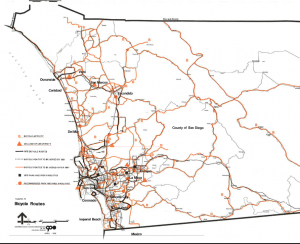
Between 1948 and today (66 years, or a single lifetime), the city of San Diego grew by a million residents. 1948 heralded the beginning of a new era in San Diego: the first freeway, Cabrillo Freeway (SR-163), was opened to the public. This 7-mile stretch through the heart of Balboa Park, San Diego's "crown jewel", was the dawn of the new era of freeway building that just wrecked havoc over the city's established urban neighborhoods. From my reading, the city of San Diego simply deeded over their own property to highway engineers and Caltrans to build freeways through the city who then subsequently did just that - built freeways throughout our city.
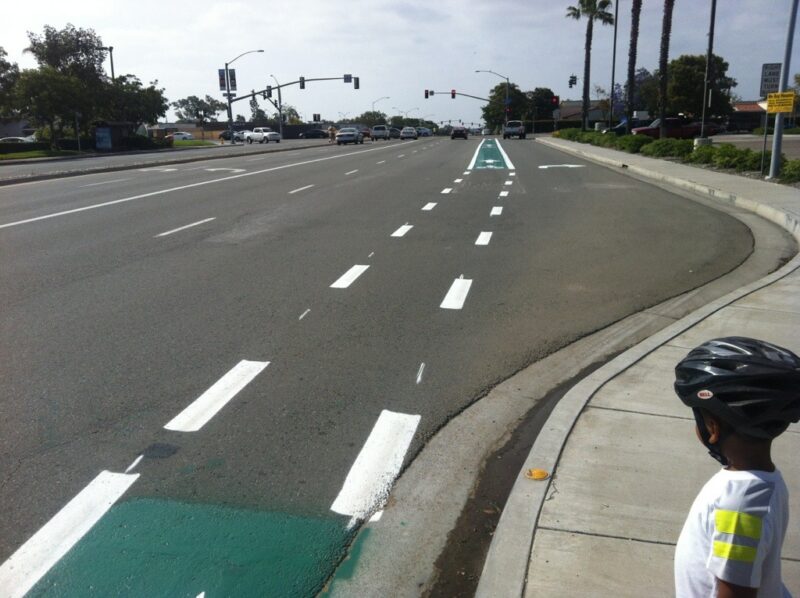
San Diego declared a bike-friendly city by USA Today based on a bike path in Coronado

To be fair to USA Today's glowing praise of our fair city, the title of this post is slightly misleading because USA Today also cited a handful of bike routes and the repeatedly delayed bike share program as a basis for declaring San Diego as a top bike-friendly city.
Well with such high praise we at BikeSD should probably be getting ready to close up our operations as meeting our mission, is now within spitting distance. If USA Today states we're in the top 10 list of bike-friendly cities in the country, we must be really close to being the world's best city for bicycling. But perhaps it would be useful to take a look at some real data at how woefully behind we are compared with nearly every single major city in the country and show how far off the mark the USA Today piece really was.
Earlier this year, the Alliance for Biking and Walking (a North American coalition of state and local bicycling and walking advocacy organizations) released their comprehensive Benchmarking Report. This report "analyzed uniform national data sources from public agencies and organizations, as well as state and local surveys, collected in 2011 and 2012. As data collection methods become standardized and more refined, the benchmark report is able to show how biking and walking impacts a whole host of factors previously too difficult to measure."

I frankly was too embarrassed to even write about this report and about where we stood as a city because of how far behind we are. To be clear, we are slowly catching up to the top bike-friendly cities like Portland and Minneapolis and less bike-friendly cities like Los Angeles or hilly cities like Seattle and San Francisco. Between CicloSDias, implementation of painted buffered bike lanes, our first road diet, the adoption of the city's and region's Bike Plans, becoming a NACTO member city, attention and support from our entire city council and mayor - to name a few things, we are finally moving along. But we are by no means anywhere close to being a top 10 bike-friendly city.
One clear indicator of the bike-friendliness of a city is determined by the number of people riding a bicycle in that city to work. For all the talk about our year-round perfect weather with "a terrain that's not too hilly or too flat", only a pitiful 0.9% ride to work (now 1.1%). Granted the data doesn't allow for the full capture of all other forms of riding, outside of commuting, but this metric demonstrates the complete unfeasibility of riding to work in San Diego which makes us as a city, ranked pretty far down the list.
Besides our ranking based on how many people ride to work, our riders aren't actually safe on the streets either with our bicycle fatality rates being 6.8 per 10,000 bicycling commuters. And while we are counting riders on some streets, we do not have accurate measurable goals to move ahead, in order to actually provide a true transportation choice to San Diegans. Unlike most cities we do not have goals to increase our bicycling rates, increase physical activity, or decrease bicyclist fatalities and we have the dubious honor of sharing this lack of measurability with cities like Wichita, Detroit, Las Vegas and Sacramento.
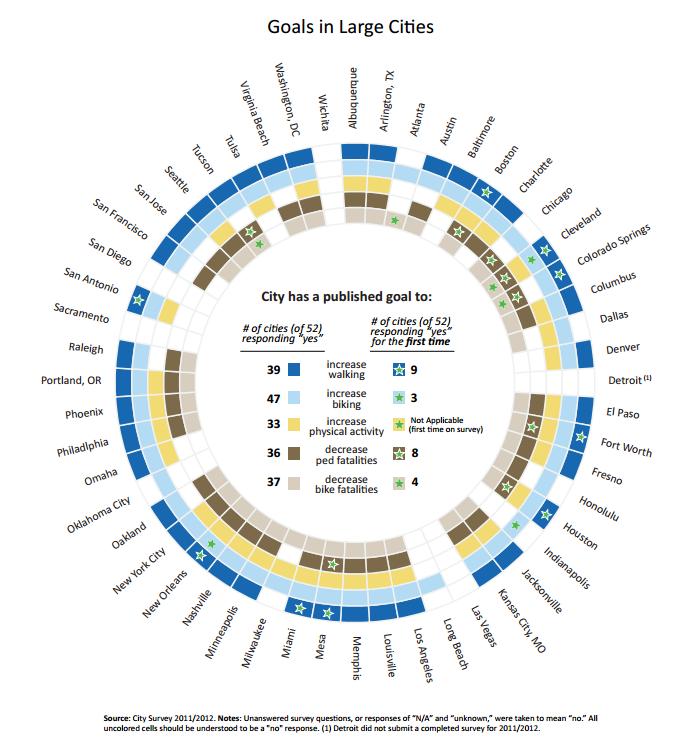
I hope none of our elected officials, policy makers or movers and shakers read the USA Today piece and declared that as a city we were done. We will never be a top bike friendly city unless the number of people riding bicycles increase and we reduce the number of deaths that occur on our city streets. Our strategy has been to push for bike infrastructure that is going to enable that shift from driving to bicycling and bicycling safely while simultaneously reducing the number of fatalities on our streets. In other words, there is a lot of work still to be done.
As our board member Bruce Shank says "what we've accomplished so far and all the infrastructure being planned will get us to becoming a world class bicycle-friendly city. In reality we live in a city where bicycles and pedestrians are a mere afterthought with deadly results. We are no where near one of the best bike friendly cities, yet."

